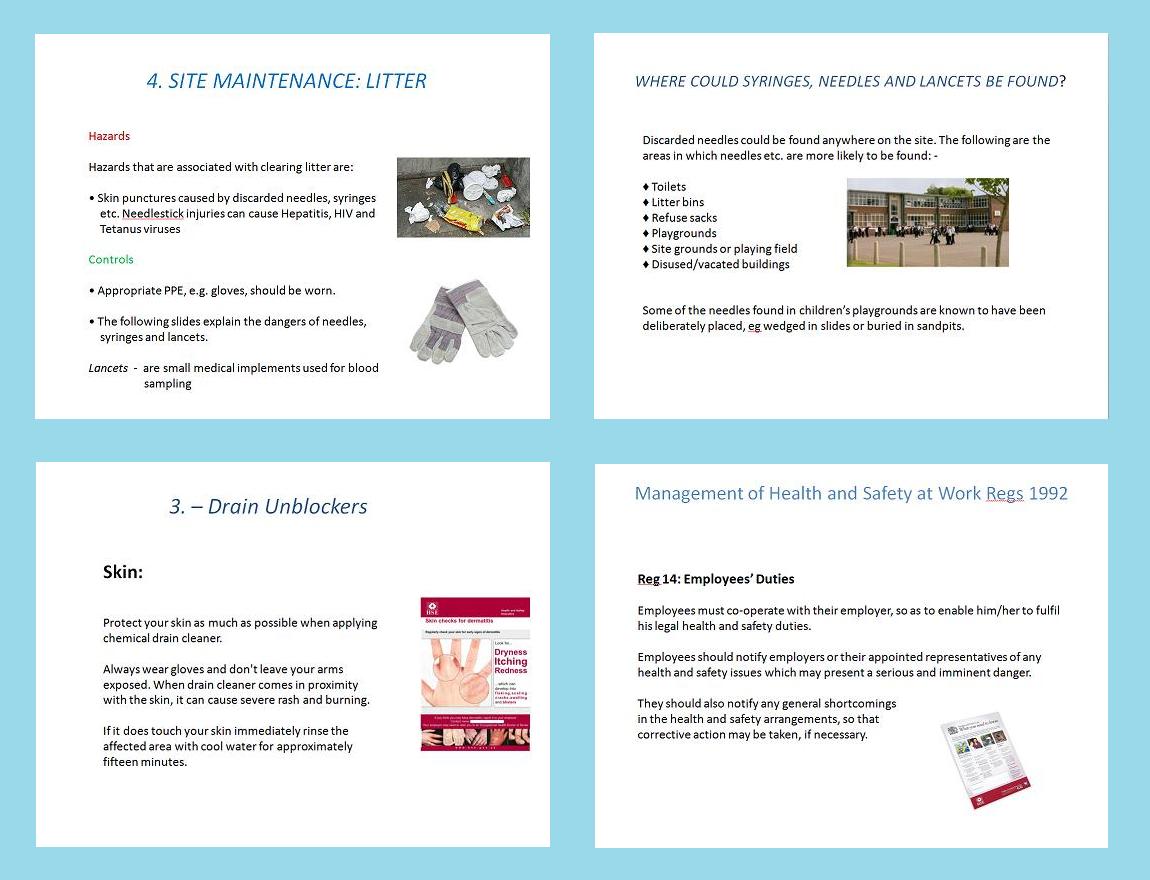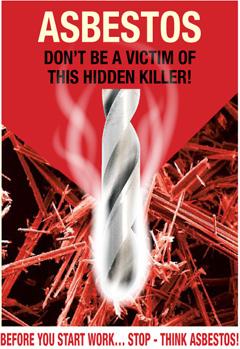Course Details
This course can be delivered as a classroom course at your premises, or in our training suite, at the Louis Pearlman Centre.
We also have an e-Learning course which can accessed through our site. £45.00 per student, but discounts are available for group bookings.
Please contact us for further details
Course Overview
This course is designed to ensure that staff understand the Chemicals Hazards in their own specific workplace and raises awareness of the Importance of controlling Chemical Hazards in Schools and colleges.
Who needs this qualification?
This qualification is specifically targeted at employees working in Schools and Colleges in the public and private sectors.
Why is this training important?
Adequately trained staff will reduce the risk of Harm from Hazardous Substances within the organisation as well as ensuring that if an emergency / spillage should occur, the correct procedures are followed to ensure that staff, Pupils/Sudents are not harmed.
Learning outcomes.
The course consists of five modules
- Introduction – Hazards associated with Hazardous Substances
- Types of substances which can cause harm
- The types of harm which can be caused by substances
- Safety Data Sheets
- Hazard Symbols
- First aid requirements

2. Control Measures
- The importance of supply labels
- Personal Protective Equipment
- Risk Assessment
- Safe Working Procedures
3. Hazardous Activity which is intrinsic to schools and colleges
- Building maintenance: painting and decorating
- Site maintenance: use of pesticides
- Site maintenance: drains and gullies
- Site maintenance: litter
- Boiler houses and switch rooms
- Swimming pool maintenance

4. Intrinsic Chemical Hazards
- Handling Chemicals
- Dealing with Spillages
- Storage of chemicals
- Specif hazards associated with;
- Drain unblockers
- Bleach
- Weedkiller
- Flammable substances
- Hand Hygiene
5. Health and Safety Legislation.
Duties of employees with regard to;
- Health & safety at work act 1974 (hasawa)
- Management of health and safety at work regs
- Control of substances hazardous to health
- Chemicals (hazard information and packaging for supply) regulations 2002 (as amended
Course Delivery.
The classroom Course is 3 Hours duration and will be delivered at your own premises or a convenient off site location. The course tutor Alan Overment has several years experience of training within the NHS and is qualified and accredited as; GradIOSH DipRSA, MIIRSM, MAIRSO, AMIIAI, AIfL.
He is also a member of NASHiCS (The National Association for Safety & Health in Care Services)
Delegates will receive a Handout Pack and Course Outline for use on the day. Delegates will also receive a Certificate of Attendance within a week of the event. All courses are fully evaluated using our own documentation, but in-house evaluation methods can be used if preferred.
Please contact us for a quote.
Example Course Content

Department for Education advice on health and safety for schools
This document summarises the existing health and safety law relevant to schools and explains how it affects local authorities, governing bodies, headteachers and other school staff. It covers activities that take place on or off school premises, including school trips.
This advice document,
Download advice document (pdf)
replaces a number of guidance documents on health, safety and security in schools, including Health and Safety: Responsibilities and Powers (2001) and Health and Safety of Pupils on Educational Visits (HASPEV 1998).
Links
Health and Safety Executive – School trips and outdoor learning activities(External link)HSE statement tackling the health and safety myths.
Health and safety advice – LAs, headteachers, staff, governing bodies(PDF, 341 Kb)
Updated 18 December 2012.
Fire safety management
Headteachers and other education managers need to manage fire safety in the same way they manage other health and safety issues – by implementing the policies agreed and monitored by the employer (that is, the LA or school governing body). To do this they will usually consult professionals from their LA, their local fire brigade and their insurers.
Regulations
All workplaces are required by the Fire Precautions (Workplace) Regulations 1997 to have an emergency plan. The plan should include the actions to be taken by staff in the event of a fire, evacuation procedures and arrangements for calling the fire brigade. It is recommended every occupied room has a fire action notice.
Responsibilities
Responsibility for fire safety in schools is usually shared between the governing body and the headteacher, and also the local authority. Between them, these bodies must ensure fire precautions at the school comply with all relevant health and safety legislation.
An appointed fire safety manager should have the necessary authority and powers of sanction to ensure standards of fire safety are maintained. The main aims of fire safety management are to
- minimise the risk of fire
- protect the means of escape
- limit the spread of fire.
The main duties regarding fire safety management are to
- make hazard and risk assessments
- be responsible for fire safety training
- produce an emergency plan and put up fire notices
- conduct fire drills
- check the adequacy and maintenance of firefighting apparatus
- consult and implement any recommendations of the local fire brigade
- conduct fire safety inspections, preferably every term
- make frequent informal checks to confirm fire safety rules are being followed
- ensure fire escape routes and fire exit doors and passageways are unobstructed, and that doors open correctly
- check that fire detection and protection systems are maintained and tested, and records kept
- ensure close-down procedures are followed
- include fire safety in the regular health and safety reports to the governing body.
It is useful to keep a fire log book to record essential information such as evacuation procedures, tests on fire fighting equipment, details of training sessions and results of fire drills.
Corporate author – The Department for Education
Protected by Crown copyright
Reproduced on this webpage, under the terms of the Open Government Licence.
Asbestos management in schools: Asbestos training
Under the Control of Asbestos Regulations 2012 information, instruction and training is required for anyone whose work could foreseeably expose them to asbestos, and those who supervise them.
This includes staff and maintenance people who may become exposed to asbestos while carrying out their normal everyday work, such as entering boiler rooms and plant rooms where asbestos is present, or changing light fittings in asbestos-tiled ceilings, or who may come into contact with or damage asbestos materials within the building fabric.
 0
0
Any training needs to be appropriate for the work and the roles undertaken by individuals.
- Asbestos awareness training is for people who are liable to disturb asbestos while carrying out their normal everyday work, and for those who manage them. This will include caretakers and maintenance staff, and could include building managers, bursars and heads.
- Taking an asbestos awareness training course does not mean that an individual can work on asbestos materials.
- Workers who intend to remove or carry out work with non-licensed materials such as asbestos cement, asbestos gaskets, and asbestos floor tiles, must have additional training in the type of work being undertaken.
- Higher risk materials including asbestos insulation, asbestos coatings and asbestos insulation board must only be repaired or removed by HSE licensed contractors.
Most school staff are not directly involved in managing the buildings or in carrying out repair or maintenance work. Staff still need to be aware of the potential hazards.
All staff should be instructed not to disturb or damage asbestos-containing materials, for example, by allowing work to be pinned to walls. They should also report damage to school fixtures or fittings that could lead to the release of asbestos fibres, for example, damage to ceiling or floor tiles, or to column seals in system-built schools.
Myth: HSE bans traditional school ties
THE REALITY
Few parents would see wearing ties at school as a safety issue. Millions of children have been wearing ties as part of their uniform for years without any problems.
Simple precautions such as removing the tie during laboratory work or around machinery make sense. But if the concern is really about children fighting, while clip-on ties may help, the real issue is discipline.
So HSE doesn’t ban school ties – it’s up to schools to make their own decisions about uniforms.
If things go wrong
Where sensible and proportionate steps have been taken by a school and its staff, it is highly unlikely that there would be a breach of health and safety law involved, or that it would be in the public interest for HSE to bring a prosecution.
Prosecutions taken by HSE invariably involve a fatality (or near fatality) where there was recklessness or a clear failure to adopt sensible precautions. The fact that an accident occurs does not mean there was a breach of health and safety law if sensible, proportionate and appropriate precautions have been taken. Fears of prosecution by schools and their staff have been grossly inflated and are unwarranted. Such fears should not be a barrier to school trips taking place.
HSE statistics indicate that in the five-year period between 2005/06 and 2009/10 HSE has brought two prosecutions involving school visits.
Resources
Incident reporting in schools
http://www.hse.gov.uk/pubns/edis1.pdf
Contains public sector information published by the Health and Safety Executive and licensed under the Open Government Licence v1.0’.

